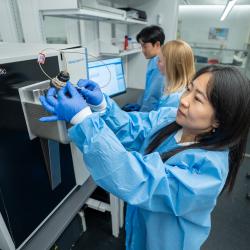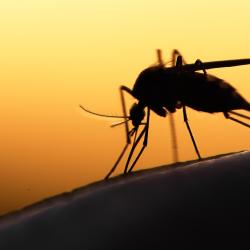A Fish-Eye View of Neural Development
Cells in the human brain do not readily regenerate, which limits their ability to recover from injury. The same is true in the eye: as with other parts of the central nervous system, retinal tissue does not grow back once it is lost due to damage or disease.

Juan Angueyra, an assistant professor with dual appointments at the Brain and Behavior Institute (BBI) and Department of Biology, wants to look this problem dead in the eye.
Angueyra’s research employs genetic tools to track the development of retinal cells from their earliest moments. When stem cells first begin to mature, they are influenced to become a particular cell type, such as muscle, bone, or nerve. This cell “fate decision” is regulated by transcription factor proteins that instruct which DNA will be employed. Angueyra’s research maps the transcription factors that govern cell fate in the eye to examine progressive development. Of particular interest are retinal photoreceptors, the cells that sense light and which can become damaged with age or disease. How, he asks, does a cell become photoreceptor? And how do photoreceptors subsequently make connections with the retina and the brain?
The answers to these questions have enormous clinical impact. If neuroscientists like Angueyra can unlock the genetic secrets of retinal development, then there may be an avenue for introducing and growing new cells in the eye rather than trying to repair existing failed ones. “The dream of scientists is to make a photoreceptor in the lab and introduce it into the retina,” said Angueyra. “If we understand how these cells mature and wire up under normal conditions, then we can understand how to achieve that in a disease state.”
According to the CDC, over 4 million Americans aged 40 and older experience low vision or are legally blind, due primarily to age-related illnesses like macular degeneration and diabetic retinopathy. Research has also firmly established a link between ocular disorders and neurodegenerative diseases. Many eye disorders present with symptoms akin to neurodegeneration, and diseases like Alzheimer’s and Parkinson’s can manifest at the ocular level.
To investigate fate decisions in the eye, Angueyra turns to a well-established animal model: zebrafish. These South Asian freshwater minnows offer a number of advantages for developmental research. Unlike mammals, which mature in utero, zebrafish embryos develop ex utero in a transparent sac. This see-through membrane affords a unique glimpse into details from fertilization onward. Zebrafish also grow rapidly, transforming from an egg to a swimming fish in about one week.
“The kind of questions I ask in zebrafish are impossible to ask in other vertebrates,” said Angueyra. “I can watch eye development in its entirety and in fine-grained detail while easily making genetic manipulations. Because we don’t know which of the thousands of transcription factors control cell fate in the eye, the transparency and developmental timeline of zebrafish make it the ideal model for investigating how photoreceptors mature.”

Photoreceptor mosaic of the adult zebrafish retina, where UV-sensitive cones are labeled in magenta, short-wavelength sensitive cones are labeled in blue, and the nuclei of mid- and long-wavelength sensitive cones are labeled in gray. Image by Juan Angueyra in "Leveraging Zebrafish to Study Retinal Degenerations."
Identifying transcription factors is just the beginning. One of Angueyra’s first experiments will be to take advantage of UMD’s state-of-the-art light sheet microscope facility to image the development of the entire eye in four dimensions—that is, to track individual cells volumetrically as they develop over time. Light sheet microscopy uses a thin plane of light to illuminate a limited layer of cells hundreds of times per second. When reconstructed, these images can show biological systems in three dimensions and in-time at excellent spatial and temporal resolution.
“I am thrilled that Juan has joined us at the BBI,” said Elizabeth Quinlan, a professor in the Department of Biology, Clark Leadership Chair in Neuroscience, and director of the BBI. “His research program expands our strengths in sensory neuroscience and plasticity. Juan combines the advantages of a powerful model system, detailed genetic analysis and 4D imaging to understand clinically important questions of photoreceptor regeneration and integration into retinal circuits.”
Prior to arriving at UMD, Angueyra served as a Postdoctoral Fellow mentored by Wei Li and Katie Kindt at the NIH National Eye Institute. He earned his Ph.D. in physiology and biophysics from Fred Rieke’s laboratory at the University of Washington, and he held an appointment in the Marine Biology Laboratory of Enrico Nasi and Maria Gómez at Woods Hole, Mass. He also trained as a physician, earning an M.D. the Universidad Nacional de Colombia, Bogotá. Angueyra credits Nasi and Gómez for jumpstarting his abiding interest in neuroscience research.
“Had I stayed in Colombia many years ago, I would have become a practicing doctor,” said Angueyra. “That role didn’t suit me. What really changed my life was when a couple of scientists in Boston took a chance on me. Once I performed research in their lab, I was hooked. As a result, one of my personal missions is to develop and train the next generation of scientists. UMD presents the perfect opportunity for that.”
###
Writer: Nathaniel Underland, underlan@umd.edu
About the Brain and Behavior Institute: The mission of the BBI is to maximize existing strengths in neuroscience research, education and training at the University of Maryland and to elevate campus neuroscience through innovative, multidisciplinary approaches that expand our research portfolio, develop novel tools and approaches and advance the translation of basic science. A centralized community of neuroscientists, engineers, computer scientists, mathematicians, physical scientists, cognitive scientists and humanities scholars, the BBI looks to solve some of the most pressing problems related to nervous system function and disease.







